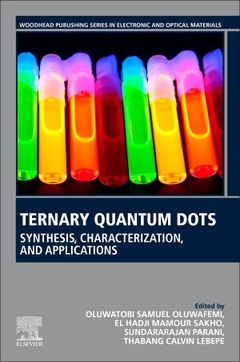Description
Ternary Quantum Dots
Synthesis, Properties, and Applications
Woodhead Publishing Series in Electronic and Optical Materials Series
Authors: Samuel Oluwafemi Oluwatobi, Mamour Sakho El Hadji, Parani Sundararajan, Lebepe Thabang Calvin
Language: English
Subjects for Ternary Quantum Dots:
209.76 €
In Print (Delivery period: 14 days).
Add to cart280 p. · 15x22.8 cm · Paperback
Description
/li>Contents
/li>Readership
/li>Biography
/li>Comment
/li>
Ternary Quantum Dots: Synthesis, Properties, and Applications reviews the latest advances in ternary (I-III-VI) chalcopyrite quantum dots (QDs), along with their synthesis, properties and applications. Sections address the fundamental key concepts of ternary quantum dots, progress in synthesis strategies (i.e., organic and aqueous synthesis), and characterization methods (i.e., transmission electron microscopy, dynamic light scattering, etc.). Properties of ternary quantum dots are comprehensively reviewed, including optical, chemical and physical properties. The factors and mechanisms of the cytotoxicity of ternary quantum dot-based nanomaterials are also described.
Since ternary chalcopyrite quantum dots are less toxic and more environmentally benign than conventional binary II-VI chalcogenide quantum dots, they are being investigated to replace conventional quantum dots in a range of applications. Thus, this book reviews QDs in various applications, such as solar cells, photocatalytic, sensors and bio-applications.
1. Fundamentals of Quantum Dot Nanocrystals 2. Properties of Ternary Quantum Dots 3. Synthesis of Ternary Quantum Dots 4. Ternary Semiconductor Nanocomposites 5. Characterization Techniques for Ternary Quantum Dots 6. Cytotoxicity of Ternary Quantum Dots 7. Bioimaging and Therapeutic Applications of Ternary Quantum Dots 8. Ternary Quantum Dots for Sensing Applications 9. Photocatalytic Applications of Ternary Quantum Dots 10. Ternary Quantum Dots for Solar Cell Fabrication 11. Ternary I-III-VI Quantum Dots for Light-Emitting Diode Devices
Dr. El Hadji Mamour Sakho received his PhD degree in Applied Physics from Mahatma Gandhi University, India in 2016. Currently he is a postdoctoral fellow in the Department of Applied Chemistry, University of Johannesburg, South Africa under the supervision of Prof. SO Oluwafemi His research focus is on the synthesis and characterization of graphene based hybrid materials for different applications such as solar cells, batteries, nonlinear optical applications, sensors, photocatalysts and polymer nanocomposites.
Dr. Sundararajan Parani received his MSc degree in Industrial Chemistry from Alagappa University, India in 2006 and his PhD degree in Inorganic Chemistry from University of Madras, India in 2015. Currently he is a postdoctoral fellow in the Department of Applied Chemistry, University of Johannesburg, South Africa, under the supervision of Prof. SO Oluwafemi. His research interests focus on the development of nanomaterials and nanocomposites for theranos
- Reviews fundamental concepts of ternary quantum dots and quantum dot-nanocomposites including the most relevant synthesis strategies, key properties, and characterization techniques
- Delves into the cytotoxicity of quantum dots looking at the factors and mechanisms that influence cytotoxicity including demonstration of cytotoxicity assays for in vitro and in vivo tests
- Touches on the many applications of ternary quantum dots including biomedical applications, applications in solar cells, sensing applications, and photocatalytic applications




